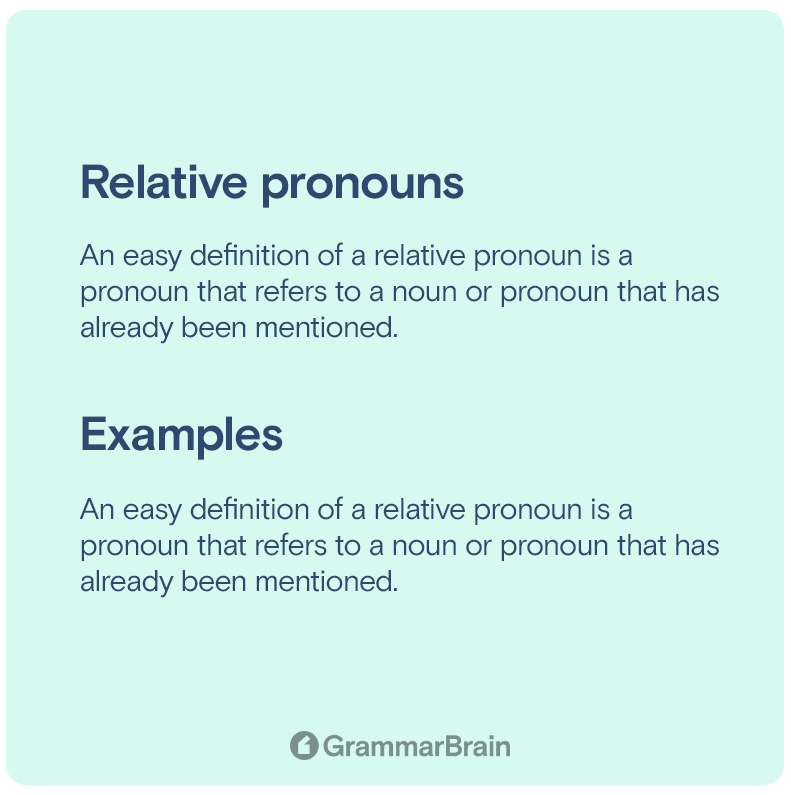A relative pronoun is a word that introduces a relative clause and connects it to the main clause of a sentence.
In grammar, a relative clause is a clause that modifies a noun or pronoun. As dependent clauses, relative clauses are often used to give additional information about something without starting a new sentence. For example, the sentence “The book that I am reading is interesting” contains a relative clause (that I am reading) that modifies the noun book.

What is a relative pronoun’s easy definition?
An easy definition of a relative pronoun is a pronoun that refers to a noun or pronoun that has already been mentioned.
For example:
The woman who called this morning is our new neighbor. (the relative pronoun ‘who‘ refers to the noun ‘woman’ already mentioned)
The dog whose collar was found in our yard must be lost. (the relative pronoun ‘whose‘ refers to the noun ‘dog’ already mentioned)
The car that hit me was going very fast. (the relative pronoun ‘that‘ refers to the noun ‘car’ already mentioned)
How many relative pronouns are there in English?
There are five commonly used relative pronouns are “who, whom, whose, which, and that.”
They are used to join two clauses together, with the relative pronoun acting as the subject or object of the relative clause. Relative clauses can be very useful for making complex ideas easier to understand.
Whomever and whoever can also be considered relative pronouns.
What is an example of a relative pronoun in a sentence?
Here are some examples of relative pronouns in a sentence:
The man who called yesterday is still in the conference room.
The conference room that was booked for the meeting has been double-booked.
The woman who lives next door is my neighbor.
The house that was built in 1900 is for sale.
I gave my book to whoever wanted it.
How to use relative pronouns?
When choosing which relative pronoun to use, consider
- whether it is referring to a person or thing and
- whether it is the subject or object of the relative clause.
Remember these rules:
Who, whom, and whose are used as relative pronouns for human objects or subjects:
For example:
She introduced me to John, who was new to the neighborhood.
Mary liked the actress who was playing Scarlett.
“Who” is used as the subject of a relative clause, while “whom” is used as the object.
For example:
The woman who won the race was very excited.
The woman whom we interviewed was very articulate.
Though often interchangeable with “who” in informal settings, “whom” should be used when referring to the object of a verb or preposition.
Remember, “who” is always the subject of a sentence or clause, whereas “whom” is always the object. If you can substitute “he” or “she” for “whom” and the sentence still makes sense, you’re using the correct form.
Here are a few examples of how to use “whom” in a sentence:
The candidate whom we hired had the most experience.
To whom should I address this letter?
The relative pronoun ‘which’ is used for both things and sometimes, animals.
Some plants, which are colorful, are toxic to pets.
My old college, which is completing its 100th anniversary in 2024, looks as good as new.
It can be used for animals when the animal does not have a name:
For example:
The iguana, which lives in our backyard, basks in the sun every day.
The guinea pig, which loves parsley, started squeaking when it saw its owner.
The relative pronoun ‘that’ is used only for things.
The relative pronoun “that” is used to refer to a thing or group of things previously mentioned or known about. It can also be used to introduce a clause or phrase which provides more information about the preceding noun or pronoun.
Here are some examples of how to use “that” in a sentence:
The book that I read was very interesting.
I’m looking for a jacket that is comfortable and stylish.
Do you know the person that lives next door to you?
This is the house that Jack built.
Shiela wants dresses that make her look slim.
Kristen wants to read stories that have a moral.
That cannot be used as the subject of a relative clause unless it is followed by a preposition
For example:
That is the conference room where we held the meeting.
The relative pronoun “whose” is used for possessive forms of people and things.
The relative pronoun ‘whose” can be used to refer to both people and things. It is used to show possession or ownership within a relative clause.
For example:
The man whose car broke down was very upset.
The book whose author is unknown is very intriguing.
Here is a summary of when to use the different relative pronouns:
- Who – People
- Whom – Possessive meaning used for people (and sometimes animals)
- Which – Things and animals
- Whose – People
- That – things and animals
More on pronouns
More resources on pronouns:
Inside this article
Fact checked:
Content is rigorously reviewed by a team of qualified and experienced fact checkers. Fact checkers review articles for factual accuracy, relevance, and timeliness. Learn more.
Core lessons
Glossary
- Abstract Noun
- Accusative Case
- Anecdote
- Antonym
- Active Sentence
- Adverb
- Adjective
- Allegory
- Alliteration
- Adjective Clause
- Adjective Phrase
- Ampersand
- Anastrophe
- Adverbial Clause
- Appositive Phrase
- Clause
- Compound Adjective
- Complex Sentence
- Compound Words
- Compound Predicate
- Common Noun
- Comparative Adjective
- Comparative and Superlative
- Compound Noun
- Compound Subject
- Compound Sentence
- Copular Verb
- Collective Noun
- Colloquialism
- Conciseness
- Consonance
- Conditional
- Concrete Noun
- Conjunction
- Conjugation
- Conditional Sentence
- Comma Splice
- Correlative Conjunction
- Coordinating Conjunction
- Coordinate Adjective
- Cumulative Adjective
- Dative Case
- Determiner
- Declarative Sentence
- Declarative Statement
- Direct Object Pronoun
- Direct Object
- Diction
- Diphthong
- Dangling Modifier
- Demonstrative Pronoun
- Demonstrative Adjective
- Direct Characterization
- Definite Article
- Doublespeak
- False Dilemma Fallacy
- Future Perfect Progressive
- Future Simple
- Future Perfect Continuous
- Future Perfect
- First Conditional
- Irregular Adjective
- Irregular Verb
- Imperative Sentence
- Indefinite Article
- Intransitive Verb
- Introductory Phrase
- Indefinite Pronoun
- Indirect Characterization
- Interrogative Sentence
- Intensive Pronoun
- Inanimate Object
- Indefinite Tense
- Infinitive Phrase
- Interjection
- Intensifier
- Infinitive
- Indicative Mood
- Participle
- Parallelism
- Prepositional Phrase
- Past Simple Tense
- Past Continuous Tense
- Past Perfect Tense
- Past Progressive Tense
- Present Simple Tense
- Present Perfect Tense
- Personal Pronoun
- Personification
- Persuasive Writing
- Parallel Structure
- Phrasal Verb
- Predicate Adjective
- Predicate Nominative
- Phonetic Language
- Plural Noun
- Punctuation
- Punctuation Marks
- Preposition
- Preposition of Place
- Parts of Speech
- Possessive Adjective
- Possessive Determiner
- Possessive Case
- Possessive Noun
- Proper Adjective
- Proper Noun
- Present Participle
- Prefix
- Predicate



